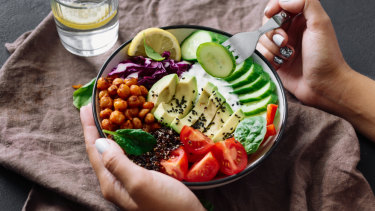A meat lover’s guide to eating less meat

For all of my adult life, I've revelled in rare rib-eye steaks and oozing camembert. I won't let go of my drumstick until I've gnawed off every bit of cartilage and golden skin, and it's best to not even talk about bacon so crisp that it won't bend for that first bite.
On the upside, eating less meat and dairy means there is more room on my plate for other delectable things.Credit:Shutterstock
Yet over the past few months, I've cut way down on my lamb chops and grilled cheese sandwiches. And if you're a meat-and-dairy eater who aches over the environmental state of our planet, then you may be thinking of doing the same thing.
Meat and dairy production alone account for 14.5 per cent of the world's greenhouse gas emissions – as much each year as from all cars, trucks, airplanes and ships combined. It's a staggering statistic.
Becoming vegan would be the most planet-friendly way to go, followed by going vegetarian. I don't know that I've got the willpower to stick to either one. I love meat and dairy too much to give them up entirely. But eating less of them – that I can do.
On the upside, eating less meat and dairy means there is more room on my plate for other delectable things: really good sourdough bread slathered with tahini and homemade marmalade, mushroom bourguignon over a mound of noodles, and all those speckled heirloom beans I keep meaning to order online.
So how much meat and dairy should we be eating? And if we reduce our intake severely, do we then need to worry about getting enough protein?
According to Marion Nestle, author and professor emeritus of nutrition, food studies and public health at New York University, if you are getting enough calories, then you are getting enough protein. (That is, unless you are an elite athlete.)
After some mental calisthenics, I landed on trying to limit myself to two to three meals that include meat, seafood or dairy per week, and thrice-daily splashes of milk in my tea (non-negotiable if I want to retain my sanity). I figure this is about a 40 per cent reduction from the six to eight meaty, cheesy, anchovy- and yoghurt-laden meals I had been eating weekly. (The rest were already meat- and dairy-free, and I don't typically eat breakfast.)
Another way to strategise is to try keeping the daily mix of what you eat to 80 per cent plant matter and 20 per cent meat, dairy and seafood. (Going vegan all day, then having a small amount of meat or cheese with dinner is one way people make this work.)
For my meat allotment, I've focused more on chicken, pork and local seafood (especially molluscs), which are generally less taxing to the environment than beef and lamb, both of which are relegated to special-occasion status.
There's no denying how processed most vegan meats are, loaded with unidentifiable ingredients, but they do scratch the itch for burgers and meatballs. These products are often a starting point for people who want to cut down on their meat intake — and, with some brands, once that faux burger patty is stuffed into a bun and loaded with condiments, it may be hard to tell the difference.
Of course, none of this is in any way a novel approach. The concept of flexitarianism has been around since the early 2000s. But somehow the term seems timeworn and not at all evocative of the pleasures of the table.
I like to loosely think of my approach as mindful meat-eating. And while the days of absent-minded chicken caesar salads and oblivious cheese-and-cracker munching are for the most part over, the likes of avocado toast, salted cashews and popcorn covered with coconut oil and nutritional yeast can fill the void.
New York Times
Source: Read Full Article





